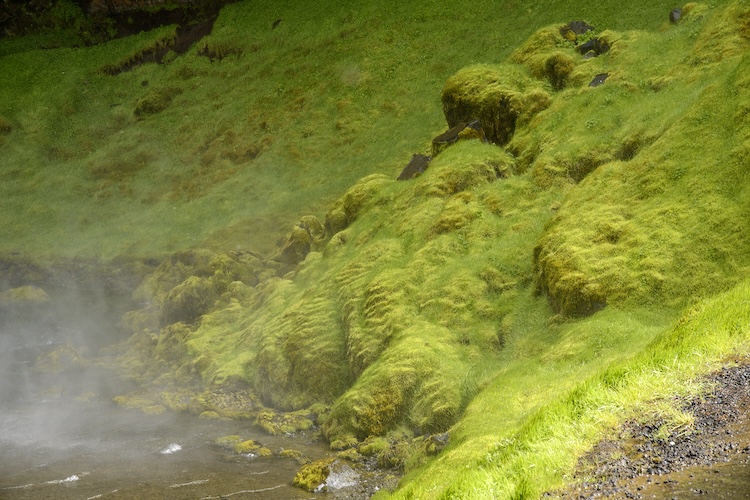Photographer Michel Eisenlohr’s new exhibition in Antibes reveals the astonishing relationship that Icelanders still maintain with their environment.
Huldufólk are literally the stuff that fairytales are made of. Yet to Icelanders they are more than just an intrinsic part of their folklore. From boulders and waterfalls to lakes, roads, lava fields, or basalt cliffs – seemingly everything in nature is said to be imbued with the mysterious powers of these “hidden people”.
Michel Eisenlohr , one of the most renowned contemporary photographers in France, explored the phenomenon and found magic indeed – in the way Icelanders integrate these natural elements, along with the legends surrounding them, in their everyday life. The photos he brought back from his travels are currently on display through 30 December 2023 at a new exhibition at the Médiathèque Albert Camus in Antibes, and are also captured in an eponymous book.
The sheer force of Iceland’s nature commands modesty and respect. But many Icelanders are inherently convinced that nature is not just alive but also inhabited by elves, gnomes, trolls and fairies. On some farms, for example, strange incidents are reported that seem to reveal the presence of hidden beings, nestling in stones and streams.
Rural superstition? Nothing is less certain, whether you wander around the most remote villages of the country or in the capital of Reykjavik and its suburbs. According to Icelanders, elves can take up residence anywhere – between two brightly coloured contemporary buildings, a few metres from a metal-clad villa or in the centre of a block of residence. Street names bear witness to the personification of these places: Álfhóll, “the Elf’s mound. Enbui, “the hermit”. Borgir, “the City”. The Latur stone, “the lazy man”. Dvergastein, “the dwarf stone”… The list of names for these shapeless hills, rocks and hollows, in the middle of a residential area or on the edge of a dual carriageway, goes on and on.
The surprising cohabitation of a modern Icelandic society and its rapidly developing urbanism alongside the tradition and age-old beliefs seems easy to laugh off at first glance. But Michel Eisenlohr, famous for his ability to sensitively capture light and the traces of time, illustrates this dual reality by taking up the challenge to photograph the invisible… Inspired by tales and legends, guided by the research of ethnologists, geographers and archaeologists, he offers us an immersion in these natural or urban places and gives us a visual account of this intangible heritage.
The best way to truly savour the essence of Eisenlohr’s Huldufólk work is by abandoning rational beliefs at the door and just allow yourself to be guided by your senses. Soon, an ethereal otherness, a pathway back to childhood and those blissful days when life was so much easier, will reveal itself. You will start to hear the elves’ voices, see their fleeting apparitions in the shadow of rocks and crevices, and feel their presence. That is when you know you have reconnected with nature, and with your inner wide-eyed child that was so easily in sync with the invisible. The functional modern apartment block or parking lot fades, the rock jumps out, ready to share its secrets with you.
Michel Eisenlohr has banned this coexistence of two worlds on camera in a way few can. But the “hidden people” are much more than folk legends and sagas – they are also messengers with a timely warning of environmental preservation and protection of a landscape filled with earthquakes, avalanches, and volcanoes. Many artists document this implicitly or explicitly, and many scholars have written about that. Michael Strmiska, an American professor of anthropology at SUNY university, New York, describes them as being “not so much supernatural as ultranatural, representing not an overcoming of nature in the hope of a better deal beyond but a deep reverence for the land and the mysterious powers able to cause fertility or famine.”
With their age-old, firm belief in the existence of a parallel universe of beings, Icelanders are heeding this stringent appeal to respecting traditional ways of preserving an environment at risk of overdevelopment. And that is where the true magic of the Huldufólk lies.
For those who want to explore Iceland’s unique and spectacular landscapes for themselves, Iceland Unwrapped tailors individual tours (disclaimer: this is not a paid or affiliated link.)
Michel Eisenlohr – “Huldufólk : Islande, le peuple caché”
Through 30 December 2023
Médiathèque Albert Camus
19 Boulevard Chancel, Antibes
Open Tuesday to Saturday from 10h to 18h.
Free access.
All photos copyright Michel Eisenlohr; photo of Mr. Eisenlohr courtesy of Michel Eisenlohr










Leave a Reply